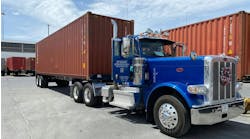When the Environmental Protection Agency (EPA) proposed changing the air pollution regulation last November, they were unprepared for the overwhelming response from the public and industry. "We received more comments on this than any other issue," said EPA Administrator Carol Browner recently during an interview on National Public Radio.
Browner didn't say whether or not she was surprised by the response from industry, but it's clear that many industry groups -- and the trucking industry in particular -- are not happy about the new regulation.
The regulation, which was officially detailed on July 18, is very complex, but focuses primarily on two items: ozone and particulate matter.
First, the EPA has decided to tighten the allowable ozone level from 0.12 parts per million to 0.08 parts per million. Although this could put many areas out of compliance, a new measuring system may help. Currently, levels are measured during a one-hour window. This can be misleading, and sometimes meaningless, because ozone levels may spike during a particularly nasty traffic tie-up or unusual weather conditions. The new regulation would allow ozone measurements over an eight-hour period, with the official level determined as an average over that time.
The second part is more quarrelsome. The agency has decided that particulate emissions should be lowered to 2.5 microns rather than the 10 microns now allowed. Electric powerplants in the Midwest, primarily coal-powered but some diesel-powered, are the main targets.
The American Trucking Assns. (ATA) says that the problem is that trucks with diesel engines are being swept up in the process. "It affects trucks substantially," says Karen Kelso, environmental analyst in the ATA's environmental affairs department. "Trucks will have trouble meeting the 2.5 standard."
The ATA claims that truck engines could only meet the new standard with equipment that is prohibitively expensive. "It would probably cost around $2,000 per truck, and it would be untested technology," says Kelso.
The EPA says the new regulation will save lives, especially for people with asthma or other respiratory ailments. Unfortunately, the agency hasn't done a good job of presenting the scientific data, and has been attacked for lacking the research to back up its contention that the new standards could save an estimated 15,000 lives annually.
Browner contends that the evidence is quite convincing: As fine-particle pollution increases, people get sicker. She cites hundreds of peer-reviewed journal articles that tracked, among other things, hospital admissions with pollution levels. The higher the levels, the more people were admitted to hospital emergency rooms with lung problems. Browner says, however, that the research was so voluminous that it would be impractical to make it all part of the official record.
The ATA and others disagree, saying that they have seen inconsistencies that make them suspect the data's integrity. They point to one instance where a researcher apparently didn't know the difference between "mean" and "average," thus changing mortality estimates by 25%. This forced the EPA to do some backpedaling.
Perhaps the ATA's strongest weapon is its contention that the EPA ruling is in violation of laws requiring all federal agencies to consider the economic impact of regulation on small businesses. The ATA says that 87% of all trucking companies are small businesses, and the effect of the pollution standards on trucking firms will be particularly painful. The ATA filed suit in the U.S. Court of Appeals in Washington, D.C., to overturn the EPA action.
With Congress in recess, and other pressing matters such as tax reform on its plate, it's not certain how this will play out. What may sway Congress in the end is public sentiment and the EPA's record. Recent data has shown that the air has indeed gotten cleaner since the passage of the Clean Air Act. Without a doubt, the EPA's policies are working -- despite industry protestations. Not only is the air getting cleaner, but the economy is more robust than it has been in decades, and some say industry has cried wolf too many times on pollution regulation. In addition, polls show that the American public embraces the idea of clean air and water and wants its environment even cleaner.
Browner points out that industry has always risen to the occasion and found affordable, practical technology to comply with pollution standards. She points to the EPA ruling that prohibited the use of Freon because it was destroying the ozone layer and causing an increased incidence of skin cancer. No specific substitute was suggested, says Browner, but industry came up with several that are now being used successfully.
Unless the trucking industry can prevent implementation of the regulation, it will be up to diesel engine makers to do the same.
Seeking to sharpen their focus on core business units, Dana Corp. and Eaton Corp. have announced making purchase agreements with each other that will allow them, in effect, to trade certain major component operations worldwide.
Dana will buy Eaton's global axle and brake operation, including its Marion, Ohio, forging operation, for $287 million. Eaton will purchase Dana's worldwide clutch business for $180 million. It should be noted that the transmission businesses of both companies are not affected by the swap.
In addition, the two manufacturers have inked a long-term agreement under which Eaton will exclusively, and globally, market a range of Class 8 drivetrain systems to North American OEMs.
Dana will continue to make and market a complete line of medium-duty axle and brake products around the world. Eaton will retain "intellectual property rights" to its current Class 8 drive axles for two years, during which time it will support R&D projects.
The multimillion-dollar transactions are to be made in cash. At presstime, the agreements were still subject to due diligence, as well as customary governmental approvals.
In related developments:
* Dana announced it is spinning off its transmission business to a unit of its Mexico-based affiliate, Spicer S.A. de C.V. Transmissions TSP, a wholly owned subsidiary of Spicer S.A., which it says will become a leading independent manufacturer of medium- and heavy-duty transmissions.
* Dana plans to consolidate two of its engine product groups. Effective September 1, the Perfect Circle administrative and engineering functions currently headquartered in Richmond, Ind., will be relocated and consolidated with similar operations at Dana's Sealed Power facility in Muskegon, Mich.
* Dana will sell all machinery, equipment, and inventory assets of its leafspring business, located in Berwick, Pa., to Hendrickson International.
As FLEET OWNER went to press, members of the International Brotherhood of Teamsters employed by United Parcel Service (UPS) had voted to authorize a strike if a contract was not reached by July 31. The bargaining is being closely monitored by trucking firms eager to see potential union positions on the eve of negotiations over a new National Master Freight Agreement.
One of the main issues for the union is the status of part-time workers. UPS officials have maintained that they are not purposely deploying part-time workers to the detriment of full-timers, but are deploying workers in the most efficient and productive way.
Although salaries are not the main issue here, Teamster officials say that the company's profits are so huge that they would like to share in a larger piece of the pie.
Safety is a also a major concern for union negotiators, and they point to the company's figures showing that injuries are more than twice that of other package express companies in the transportation industry.
UPS, which raised the weight limit on packages from 70 to 150 lb., denies that workers have been harassed for asking for help. However, they say that drivers sometimes can be unreasonable when they are at customer pickup sites and want to call in for help with a package. "This can waste a lot of time," says a UPS official, "and it's poor customer service."
Repeat that: A report by the National Institute for Occupational Safety and Health (NIOSH) points to research showing a relationship between certain physical activities and repetitive motion injuries. At the same time, NIOSH said the number of injuries and illnesses continue to decline. Opponents of ergonomics standards called the study inconclusive. Meanwhile, a key House subcommittee has called for a year-long moratorium on any attempt to regulate repetitive stress injuries.
A sucking sound? In its first report since the North American Free Trade Agreement (NAFTA) became effective three years ago, the Clinton Administration claims the trade pact has been responsible for modest economic gains throughout the region.
Thirsty? Time is running out on the congressional reauthorization of the $155 billion Intermodal Surface Transportation Efficiency Act, affectionately known as ISTEA. One issue the bill likely will sidestep is truck productivity. Talks between the railroad and trucking leaders have all but collapsed, leaving any hopes for increased truck sizes and weights all but dead.
Swift challenge: The EEOC is challenging Swift Transportation Co.'s policy of having new drivers trained by experienced drivers of the same sex. The policy was adopted by the fleet to prevent sexual harassment in its training program.
Time for a change? The Federal Highway Administration has begun the laborious process of wading through the roughly 500 comments submitted on the hours-of-service rulemaking as it begins the process of revamping the 40-year-old rules. The process will likely take the better part of a year before the agency releases proposed revisions.
A 1993 TMC position paper continues to exert influence on product design by truck and component makers.
Through its Tomorrow's Truck Program, The Maintenance Council (TMC) of the American Trucking Assns. in 1993 conveyed to truck makers and component suppliers a number of vehicle enhancement requests from users, including more fuel savings, improved durability, and easier maintenance. During this summer's TMC meeting in Tucson, manufacturers provided progress reports on meeting these requests.
During a session entitled "Manufacturers Respond To Tomorrow's Truck User Requests," Freightliner Corp.'s Gary Rossow said that truck makers and component suppliers used the Tomorrow's Truck Committee requirements as "performance tools with which to guide design engineers." As a result, truck makers incorporated a variety of design and assembly steps into their products to reduce life-cycle costs.
Rossow noted that since '93 the influence of these steps contributed to an expansion of the standard warranty on trucks, from 1 yr./100,000 mi. to 3 yr./350,000 mi.
During the same time period, average fuel economy has gone up approximately 6%, and is expected to reach 7.5 mpg by 1998. Rossow predicted that average fuel economy should hit 10 mpg by 2003.
Tremendous strides have been made in improving on-board vehicle electrical systems, which once represented a major maintenance expense for fleets. According to Rossow, there's less need for electrical maintenance now because there has been "more extensive use of sealed connectors, heavy-duty contact switches, and standardized wire coding, as well as dash gauges and switches that can more easily be replaced."
Driver comfort and safety have also been greatly enhanced. "Today's new vehicles average 74 decibel interior cab noise, softer front and rear suspensions enhance comfort, and improved HVAC systems reduce temperature stratification. Entry and egress for drivers has been made less dangerous with redesigned steps and handholds. The process of driving is also safer," Rossow continued. "Three-point belts with height adjustment, and improved seat and belt pre-tensioning systems greatly improve the driver's chances of survival in the event of frontal impacts and rollovers."
Bill Stahl, Cummins Engine Co., touched on several specific areas of powerplant improvement. He noted that fuel efficiency attributed solely to the engine increased an average of 1% a year since 1993. In addition, oil drain intervals have been increased and water pressure within the cooling system has been reduced. This has produced a double-edged effect -- minimizing leaks and lowering parasitic losses by reducing water-pump horsepower requirements.
Stahl also noted that on-highway engines now run for 20,000 miles with no unscheduled maintenance. In addition, serviceability improvements have been made. Primary among these, fleets can be alerted to upcoming service needs via electronic data from engine ECUs.
Rockwell Automotive's Dale Bell discussed increases in drivetrain efficiency. He observed that new multi-viscosity and synthetic lubes in gearboxes and rear axles mean a 1% fuel savings. He credits reduced sump requirements in gearboxes and rear axles with a 0.5% improvement, and direct transmissions with up to 4%.
Long-anticipated voluntary standards for uniformly measuring the crashworthiness of heavy-duty truck designs are moving closer to adoption by SAE. A six-year, $3-million research project conducted by the group and funded by government and industry has been concluded.
Guidelines developed from the study will next go to the SAE standards committee, which will decide whether to approve them as recommended testing procedures. If approved, the standards would be available for use by government agencies and truck OEMs to evaluate occupant-protection crash testing.
Wright Express Co. and American Express Co. have announced they will jointly market a commercial fleet card to the federal government and will develop similar products for use by private corporations.
The marketing agreement will allow the two firms to offer a fleet card tailored to an upcoming General Services Administration (GSA) bid that will award multiple government contracts for purchasing-, travel-, and fleet-card payment programs starting next November.
According to Wright Express president & CEO Paul Walsh, the firms will also develop joint programs customized for businesses. Like the GSA product, these will provide an integrated system for managing multiple cards. Walsh also noted that "expanded offerings" arising from the joint agreement are planned for release later this year.
General Motors Corp.'s final shares in Volvo GM Heavy Truck Corp. have been transferred to Volvo Truck Corp. of Gothenburg in exchange for preferred stock in the Swedish company. The U.S. company will now be called Volvo Trucks North America Inc., while the Canadian operation will undergo a similar name change later this year.
GM will retain one member on the North America operations board of directors, according to a Volvo Truck spokesperson.
The heavy-truck company began as a joint venture in 1988, with Volvo holding 76% ownership and GM 24%. Exercising an option in the original joint venture agreement, Volvo increased its share to 88% in 1992.
The 1997-98 edition of The Private Fleet Directory is now available from Transportation Technical Services. Over 24,000 firms that transport their own products or provide services are listed in the 1,800-page publication. Each firm operates 10 or more trucks and/or tractors. More than 2.5-million vehicles -- trucks, tractors, and trailers -- are represented by the fleets listed, up 6% from the previous edition.
Each private fleet profile is new and features company name; fleet headquarters address; fleet type; number of trucks, tractors, and trailers; trailer types; and equipment by GVW class. Information also indicates if maintenance is performed at the facility, as well as the name, title, phone, and fax number of the executive responsible for managing fleet operations and specifying equipment.
The directory comes in a single print volume for $295. Individual state editions are offered, plus all or any part is available on disk or CD-ROM. Database inquiries are free and all information comes with a money-back guarantee.
For more details, contact TTS in Fredericksburg, Va., toll free at 888-ONLY-TTS, fax 540-899-1948, or visit their Web site at www.ttstrucks.com.


